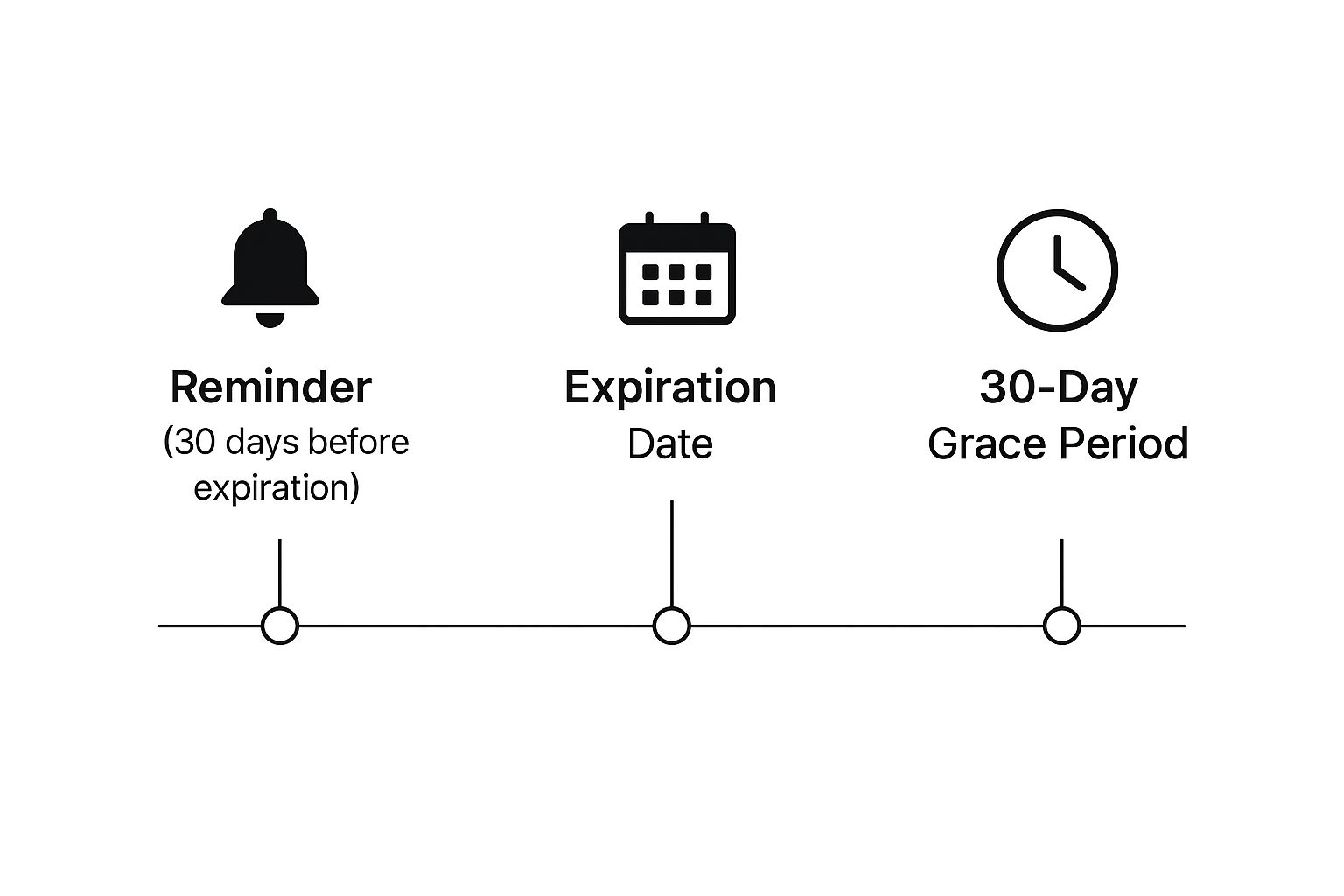To keep your domain name, you need to complete the renewal payment with your registrar before its official expiry date hits. If you miss that deadline, your website, emails, and your entire online brand are immediately at risk. This isn't just a small hiccup; it can lead to expensive recovery fees or, in the worst-case scenario, the permanent loss of your digital address.
Why Domain Renewal is a Non-Negotiable for Your Business
Losing your domain name is more than just a minor inconvenience—it's a direct hit to your business operations. The second your domain expires, your website vanishes from the internet, and every email account linked to it stops working.
This kind of sudden outage can bring sales to a screeching halt, sever communication with your customers, and instantly tarnish the brand trust you’ve spent years building. Picture a potential client trying to visit your site only to be met with an error page. Or a customer sending an urgent email that bounces right back. The damage is instant and can be incredibly difficult to undo.
The Australian Context
Here in Australia, holding onto your digital identity is especially important. The local market is overwhelmingly dominated by the .com.au extension. As of 2025, a staggering 74% of all registered domains in Australia end in .com.au, which shows just how much trust local consumers place in it.
This isn't by accident. The strict eligibility rules mean a .com.au address acts as a badge of honour, signalling you're a legitimate, local business. If you'd like to dig deeper, you can explore more about Australian domain trends to see how the market works. Letting your .com.au domain slip away doesn't just take you offline; it disconnects you from a trusted Aussie ecosystem.
This timeline gives you a quick look at what happens right after a domain passes its use-by date.

As you can see, there's a short window—the grace period—where you can get it back easily. After that, things get much more complicated and costly.
Forgetting to renew a domain is like handing the keys to your shop over to a complete stranger. A competitor could easily snap up your expired domain, redirecting all your hard-earned traffic to their own website and cashing in on your brand's reputation. This isn't just a hypothetical risk; it's a common and devastating outcome for businesses that aren't prepared. Being proactive is your only real defence.
The Four Stages of Domain Expiration
Here's a quick summary of what happens after your domain's expiry date passes.
| Stage | Typical Duration | What Happens to Your Site | Your Next Action |
|---|---|---|---|
| Expiry & Grace Period | 0–45 Days | Website and emails go offline. The domain is "parked" by the registrar. | Renew immediately through your registrar at the standard price. |
| Redemption Period | 30 Days (after grace) | The domain is still inactive but is now much more expensive to recover. | Pay a significantly higher "redemption fee" plus the renewal cost. |
| Pending Deletion | 5 Days (after redemption) | The domain is locked. It cannot be recovered or renewed at this point. | It's too late. You have to wait for it to be released to the public. |
| Public Release | After deletion | The domain becomes available for anyone to register on a first-come, first-served basis. | Try to re-register it as soon as it becomes available, but you'll be competing with others. |
Once your domain hits that "Pending Deletion" stage, it's out of your hands. The best way to avoid this entire stressful process is to either renew it well in advance or, even better, set it to auto-renew.
Set Up Auto-Renewal and Never Worry Again
The easiest way to keep your domain secure and protect your online brand is to simply automate the whole renewal process. Think of it as your digital insurance policy. Setting up auto-renewal is a powerful “set it and forget it” strategy that takes human error—like a missed email or a forgotten calendar reminder—completely out of the equation.
Most domain registrars make this incredibly easy to set up. You'll usually find the option tucked away in your account dashboard, under a section like "My Domains" or "Domain Manager". Just find the domain you want to lock down and look for a toggle switch or a checkbox labelled "Auto-Renew."
Finding and Enabling Auto-Renewal
While the dashboard layout will look a bit different from one provider to the next, the basic steps are always the same. A good registrar will have a clean, clear interface that makes managing multiple domains a breeze. If you're curious about how different providers stack up, we've put together a handy guide on choosing the best domain name registrar.
Here’s a look at what a typical domain management dashboard might look like.

This kind of centralised view puts all the important info, like expiry dates and renewal status, right at your fingertips, making it simple to flick that auto-renew switch on or off.
Once it's switched on, your registrar will automatically bill your saved payment method when your renewal date gets close. But here’s the catch: the system is only as reliable as your payment details. The most common reason an auto-renewal fails, believe it or not, is an expired credit card. It’s a small oversight that can have disastrous consequences.
Key Takeaway: Always use a primary credit card with a long expiry date for your auto-renewals. I even recommend setting a calendar reminder for yourself one month before your card expires. That gives you plenty of time to hop in and update your details without any last-minute panic.
This proactive mindset is especially important here in Australia. The .au domain space is tightly governed to ensure only eligible entities can hold a prized .com.au address. Given that .com.au domains make up nearly three-quarters of all local registrations, it’s clear how much Aussie businesses value keeping their brand’s online home secure.
Of course, auto-renew is a fantastic safety net, but there are times when you need to get hands-on. Maybe you're switching to a different credit card, trying to line up renewal dates for a bunch of domains, or you just prefer to have total control over your spending. Whatever the reason, a manual renewal puts you firmly in the driver's seat.
The good news? Registrars have made this process incredibly simple. While the exact button names might differ slightly, the overall flow is pretty much the same no matter who you're with.
Finding and Renewing Your Domain
First up, you'll need to log into your account with your domain registrar. From there, head over to the section that lists all your domains—this is usually called something like "My Domains," "Domain Manager," or a similar variation. Think of this as your command centre for everything domain-related.
Once you're looking at your list, find the specific domain you want to renew. You should see key details right next to it, like its expiry date and current status. Look for a prominent button or link that says "Renew" or "Renew Now."
A quick tip from experience: always take a second to double-check you've selected the right domain. I've seen people accidentally renew a domain they were planning to let go of, simply because they were rushing through a long list. A quick glance can save you a headache later.
After you click to renew, you'll get a choice of how long you want to extend your registration.
- One-year renewal: This is the default for most people and gives you the most flexibility year to year.
- Multi-year renewal: You can often lock in your domain for two, three, five, or even up to ten years. This is a savvy move if you know you're keeping the domain long-term, as it protects you from future price hikes and cuts down on annual admin.
Pick your term, and you'll be whisked away to the checkout page. Here, you can confirm your payment details—either using a saved card or adding a new one—and complete the purchase. The renewal should show up in your account almost immediately, giving you peace of mind.
What Happens When Your Domain Expires
So, you’ve missed the renewal deadline. It’s that sinking feeling every website owner dreads, but don't hit the panic button just yet. Missing the expiry date doesn’t mean your domain is instantly lost forever. Instead, it kicks off a critical, multi-stage process that gives you a chance to get it back—as long as you act fast.

The first thing you'll notice is your website and any associated emails will go offline. Your domain registrar will typically "park" your domain, which means anyone visiting your URL will see a generic landing page instead of your site. At this point, you've officially entered the Grace Period.
The Grace Period
This is your first and best window of opportunity to fix things. The Grace Period usually lasts anywhere from a few days to around 45 days, depending entirely on your registrar's policy. During this time, you can still renew your domain name at the standard price, with no extra penalties.
Think of it as your registrar holding the door open for you. All you have to do is log in to your account, find the renewal section, and complete the normal payment process.
The Redemption Period
If you miss the Grace Period, things get much more serious and a lot more expensive. Your domain then slips into the Redemption Period, which typically lasts for about 30 days. Your site is still offline, but now, getting your domain back comes with a hefty fee.
This "redemption fee" is a penalty charge slapped on top of the regular renewal cost and can easily be $100 or more. It's a painful and costly lesson in the importance of renewing on time.
I once worked with a small bakery owner in Melbourne who completely forgot about her domain expiry. Her online ordering system went down on a Friday morning, causing absolute chaos. Luckily, she was still in the Grace Period. She logged in, renewed immediately, and her site was back online within hours, saving the weekend’s business. Her story is a perfect example of why you must act fast.
After redemption, the domain enters a final "Pending Deletion" phase for about five days. At this stage, it's locked, and you can't do anything. Once that’s over, it's released back to the public, where competitors or domain squatters can snap it up in seconds.
Smart Tips for Domain Management and Savings
Managing your domain name well is less about putting out fires and more about making sure they never start. A little bit of forward-thinking not only dodges potential disasters but can also save you a surprising amount of cash and headaches down the line.
One of the simplest yet most effective moves you can make is renewing your domain for a longer period. While paying year-to-year is common, locking in your domain for three, five, or even ten years has two massive upsides. First, you secure today’s price, which shields you from the annual price hikes that registries and registrars often pass on. Second, it’s one less thing to worry about every 12 months.
Developing Proactive Habits
Beyond just locking in a longer term, a couple of simple habits can be the ultimate safety net. The goal here is to make it impossible to miss a critical renewal notice from your registrar.
Think of these as non-negotiable steps to protect your online address:
- Keep Your Contact Info Fresh: Your registrar account's email address needs to be one you check religiously. This is where all the expiry warnings and renewal notices will land. An old, forgotten email address is a recipe for disaster.
- Set Your Own Reminders: Don’t just rely on your registrar’s emails. Pop a reminder in your own calendar for 60 days before your domain is due to expire. This gives you plenty of breathing room to sort out any payment issues or decide on your renewal strategy without the last-minute panic.
The real secret to smart domain management is shifting from a reactive "Oh no, it's expiring next week!" mindset to a proactive one. It transforms a potential crisis into just another scheduled task you have total control over.
This forward-thinking approach is also crucial if you ever decide to move your domain to another provider. For instance, if you want to consolidate all your services with a new host, you'll need to kick off a domain transfer, and that’s a process you want to start well before any expiry dates are looming. If you’re thinking about making a switch, our guide on how to transfer a domain name breaks down exactly what you need to do.
Ultimately, putting these simple practices in place means you’ll never have to deal with the stressful and often expensive process of trying to get an expired domain back.
Common Domain Renewal Questions Answered
Even when you've got the renewal process down pat, a few specific questions always seem to pop up. Getting straight answers can save you a lot of last-minute stress and help you make the right call for your website and your wallet.
Let's tackle some of the most common ones I hear.
What Happens If My Auto-Renew Payment Fails?
This is a big one, and it's a totally valid concern. If your credit card on file has expired or the payment fails for any other reason, don't panic. Your registrar won't just let your domain disappear overnight.
You'll get an immediate notification, usually via email, and they'll typically send a few more reminders after that. This triggers what's called a grace period, giving you a window of time to log in, update your payment details, and push the renewal through manually. The key is to act quickly as soon as you see that first email.
Can I Renew My Domain with a Different Company?
Another frequent question is whether you can simply renew your domain with a different registrar, maybe one that's offering a better price. The short answer here is no. A renewal has to happen with your current registrar.
If you want to switch providers, what you're actually looking for is a domain transfer. It’s a completely different process. A good rule of thumb is to start a transfer at least a month before your domain is set to expire. This gives you plenty of buffer to sort out any unexpected hitches.
It's not uncommon to wonder why your renewal price is higher than what you paid the first time. This is almost always because a first-year promotional discount has run its course. Registrars often use a tempting low price to get you in the door, with the fee reverting to the standard rate for all future renewals.
How Far in Advance Can I Renew My Domain?
You definitely don't have to wait until the eleventh hour. Most registrars let you renew your domain at any point during its active registration period.
In fact, you can typically register or renew a domain for a total of up to 10 years into the future. Renewing early is a savvy move—it locks in the current price against future increases and gives you one less thing to worry about. You can get back to focusing on your business instead of juggling admin tasks.
Ready to secure your domain without the hassle? At Hosting Tap, we make it simple to manage, renew, and protect your most important digital asset. Secure your online brand today.





